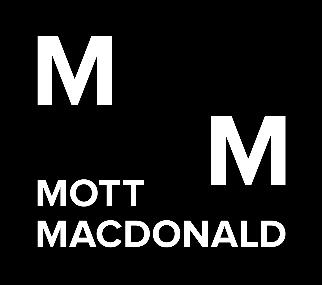

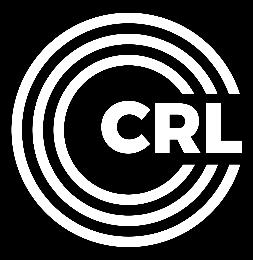




Acronym Definition
CEMP
Construction Environmental Management Plan
CRL City Rail Link
CRLL City Rail Link Limited
DWP Delivery Work Plan
EFC East Facing Connection
HNZPT
Heritage New Zealand Pouhere Tāonga
HNZPTA Heritage New Zealand Pouhere Tāonga Act 2014
NAL North Auckland Line
RMA
Resource Management Act 1991
WFC West Facing Connection
Term Definition
Koiwi tangata
Human skeletal remains Taonga tūturu Maori artefacts
The City Rail Link (CRL) project comprises the construction, operation and maintenance of a 3.4km underground passenger railway, running between Britomart Station and the North Auckland Rail Line (NAL) near Mt Eden Station. CRL Enabling Works commenced in December 2015 and the procurement of the main works contract (C3 Alliance) is being progressed with contract award likely in the first quarter of 2019. To allow works to commence as soon as possible upon award of the C3 Alliance, City Rail Link Limited (CRLL) are obtaining the necessary authorisations for demolition of buildings in the Mount Eden construction support area (CSA) and active construction zone (ACZ).
This Historic Character Delivery Work Plan (DWP) relates to the demolition of properties in the Mt Eden CSA. This is an advanced package of work on the CRL Project’s critical path, proposed to be completed in time to allow unimpeded access to subsequent main works construction under C3 and C5.
This advance works project is for the pre-construction phase of the work only. The physical demolition works are proposed to be undertaken by the C3 Alliance
It is proposed to demolish all buildings and structures in the Mount Eden ACZ and CSA (“the Project”), as identified in Figure 1 1 below. The Project is being undertaken in accordance with the CRL Designation 2500-6, confirmed in November 2015 and the Aotea Station to North Auckland Line (A2NAL) suite of resource consents approved in November 2016. The conditions of these authorisations require the preparation of an Outline Plan (OP), Delivery Work Plans (DWP) and Management Plans (MP). This Historic Character DWP is prepared in accordance with the CRL Designation and resource consent conditions and identified in the hierarchy of documentation illustrated in Figure 1 2
The properties included in the Project area were purchased by Auckland Transport for the purposes of the CRL Project and are currently under CRLL’s management.
Most of the properties to be demolished are tenanted as of October 2018 with the remainder unoccupied. CRLL plan to commence the process of vacating the properties towards the end of 2018 and early 2019 to ensure sites are vacant in reasonable time ahead of the planned disconnection of services. Demolition will be undertaken in a staged manner the order of which is to be confirmed by the C3 Alliance. All buildings and structures will be removed to ground level, with the retention of some existing foundations where necessary for site stability. A soft strip of salvageable materials will be carried out where possible. All demolition material will be removed from the Project area and disposed of at approved facilities.
The Project area will be fenced, with lockable gates, to prevent unauthorised entry. Where appropriate, solid plywood fencing will be used, with appropriate signage prohibiting unauthorised entry and identifying hazards.
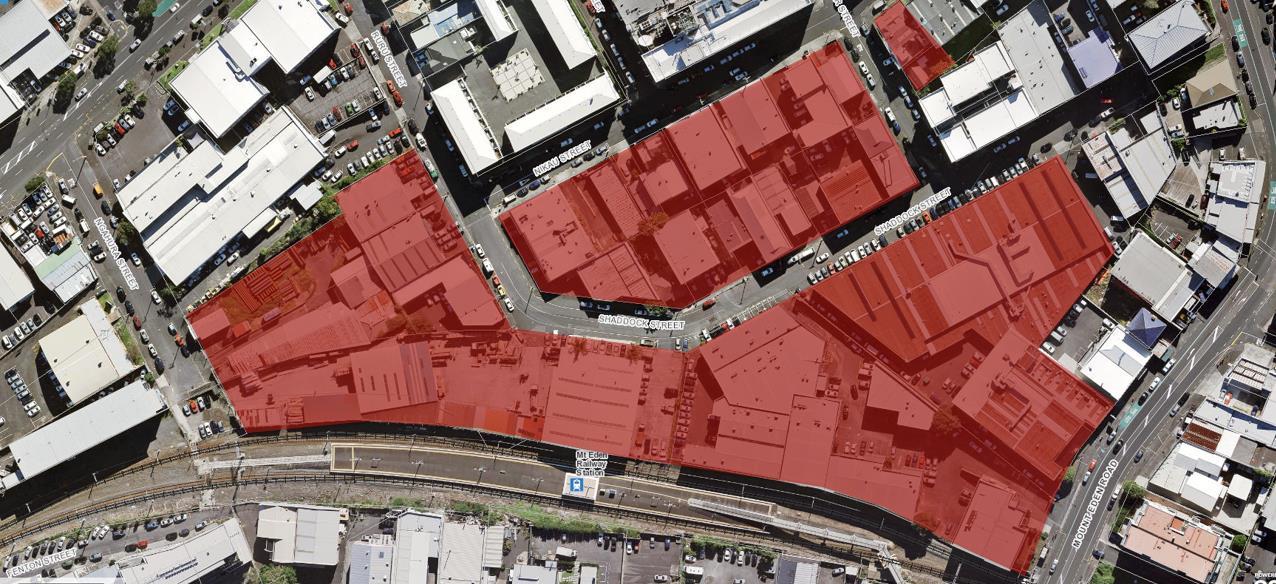
1 1: CRL Mt Eden demolition area Arrows indicate the location of buildings relevant to the Historic Character DWP Archaeology Section located within the demolition area at 31 Shaddock Street (left arrow), 19 Shaddock Street (central arrow) and 6 Flower Street (right arrow)

The Historic Character Delivery Work Plan (DWP) (Archaeology Section) (referred to as ‘this DWP’) has been prepared to manage adverse effects on archaeology that may result during the Project. The objective of the DWP is to provide a framework for the avoidance, remediation or mitigation of adverse effects on archaeological remains during construction, as far as reasonably practicable.
This DWP is required under CRL Designation Condition 42. It has been prepared by Clough & Associates Ltd and will form part of the Construction Environmental Management Plan (CEMP) for the Project. Collectively, the CEMP and this DWP will support the Outline Plan for the Project.
Table 1.1 identifies the designation conditions relevant to this DWP and where they are addressed in the document
Condition No. Condition
42.1 A Historic Character DWP shall be prepared to manage the adverse effects on built heritage and archaeology that may result during construction of the City Rail Link or any part of it.
42.2 The objective of the Archaeology section of the Historic Character DWP is to avoid, remedy or mitigate adverse effects on archaeological remains during construction, as far as reasonably practicable.
This document
This document
42.3 To achieve the above objective the following matters shall be included in the Archaeology section of the Historic Character DWP:
(a) Constructor roles and responsibilities, stand-down periods and reporting requirements are to be clearly identified;
(b) How procedures for archaeological investigations and monitoring of preliminary earthworks are to be implemented in areas where there is potential for archaeological remains to be discovered;
Sections 3.1, 5.6, 5.8,
Sections 5, 5.3, 5.4 and 5.8
(c) Procedures for the discovery of, including accidental discovery of archaeological remains including:
(i) The ceasing of all physical construction works in the immediate vicinity of the discovery;
(ii) Practices for dealing with the uncovering of cultural or archaeological remains and the parties to be notified (including, but not limited to, appropriate iwi authorities, the Auckland Council Consents Monitoring officer, the New Zealand Historic Places Trust [now Heritage New Zealand Pouhere Taonga - HNZPT], and the New Zealand Police (if koiwi (human skeletal remains) are discovered);
(iii) Procedures to be undertaken before physical works in the area of discovery can start again, including any iwi protocols, recording of sites and material, recovery of any artefacts, and consultation to be undertaken with iwi, Auckland Council Consent Monitoring officer and Heritage Unit, and with the New Zealand Historic Places Trust [now HNZPT]; and
(iv) Procedures for recording any archaeological remains or evidence before it is modified or destroyed, including opportunities for the conservation and preservation of artefacts and ecofacts (biological material) that are discovered. Consideration shall be given to the incorporation of in-situ material or artefacts into the design of stations and / or public places associated with the City Rail Link project. Consideration shall also be given to the provision for ‘post-excavation’ assessment analysis and publication of material within 24 months of completion of construction.
(v) Provision for ‘post-excavation’ archiving, assessment and analysis of the archaeological records and materials; publication of results of that work within 24 months of completion of construction assessment analysis and publication of material within 24 months of completion of construction.
(d) Training procedures for all contractors are to be undertaken in advance of construction, regarding the possible presence of cultural or archaeological sites or material, what these sites or material may look like, and the relevant provisions of the Historic Places Act 1993 [now the Heritage New Zealand Pouhere Taonga Act 2014] if any sites or material are discovered;
Sections 5.3, 5.4, 5.5, 5.8
Sections 5.3, 5.4, 5.5, 5.6, 5.8
Sections 5.4, 5.6, 5.8
Sections 5.5, 5.6, 5.7, 5.8, 5.9, 5.10
Sections 5.7, 5.9
Section 4
Condition No. Condition
(e) Cross references to the specific sections in the Communication and Consultation Plan which details how the Auckland Council Heritage Department, the New Zealand Historic Places Trust [now HNZPT], mana whenua (see condition 8) are consulted, and the communication with the general public on the management of the adverse effects relating to archaeology.
Relevant section of DWP
Section 6
Two of the buildings to be demolished – at 31 Shaddock Street and 6 Flower Street – are of pre-1900 date and have been recorded as archaeological sites: R11/3079 and R11/3080 respectively in the New Zealand Archaeological Association’s site recording scheme. The sites consist of the buildings themselves and the extent of the properties, which may include associated subsurface remains.
Provision for archaeological investigation and recording of the buildings at 31 Shaddock Street and 6 Flower Street prior to and during demolition is provided for in this DWP.
Another property at 19 Shaddock Street, where a 1920s timber building is located, has been identified as having some potential for subsurface archaeological remains relating to earlier (pre1900) occupation of the site.
An archaeological midden site (R11/51) was recorded in the 1960s near the railway lines and within 31 Ruru Street but was subsequently destroyed by development works.
As the advance works provided for in this DWP will be limited to site clearance following building demolition, the potential for impacting on subsurface archaeological remains will be limited. However, the possibility of exposing subsurface archaeological remains (including at 31 and 19 Shaddock Street and 6 Flower Street) will be managed through this DWP and an Archaeological Authority (no. 2017/793) issued by Heritage New Zealand Pouhere Taonga (HNZPT) (see Appendix A).
3.1
The Project Archaeologist will be responsible for ensuring that the archaeological requirements set out in this DWP and in the Heritage New Zealand Pouhere Taonga Act 2014 (HNZPTA) authority are fulfilled. This includes ensuring that a buildings archaeologist is available to investigate and record the buildings at 31 Shaddock Street and 6 Flower Street prior to and during their demolition, and that an archaeologist is available to inspect the site at 19 Shaddock street during site clearance and to respond to call-in by the construction contractor if any suspected archaeological remains are exposed. It also includes ensuring that the archaeological team adheres to the contractor’s site safety requirements.
The Project Archaeologist will also be responsible for reporting to the relevant parties regarding the archaeological work.
Prior to the start of building demolition, the Project Archaeologist and Mana Whenua representatives will meet with the demolition contractor(s) on site to brief them on the archaeological and cultural requirements for the Project.
The Project Archaeologist must be given at least two weeks’ notice by the contractor that demolition works at 31 Shaddock Street, 19 Shaddock Street and 6 Flower Street are about to begin. The construction contractor will keep the Project Archaeologist informed as to the work schedule and any changes that may arise.
The contractor will not begin demolition at 31 Shaddock Street or 6 Flower Street until the Project Archaeologist has confirmed that pre-demolition recording is complete, and will liaise with the Project Archaeologist during the demolition of the buildings so that further investigations can be carried out, as set out in section 5.1.
As set out in sections 5.3, 5.4, 5.5 and 5.8 of this DWP, the construction contractor will temporarily cease works and call-in the Project Archaeologist if suspected archaeological remains are exposed during site clearance when an archaeologist is not present, so that the remains can be assessed and recorded.
As set out in sections 5.4 and 5.8 of this DWP, the construction contractor will give the Project Archaeologist sufficient time and opportunity for the recording and sampling of any archaeological features or deposits encountered, and will not resume clearance works in the immediate vicinity until the archaeological work is completed.
3.3
Table 3 1 outlines the contact details of the Project Archaeologist, Mana Whenua, Auckland Council Heritage and HNZPT.
Table 3 1: Contact details
Title Name Contact Details
Project Archaeologist (and Approved Archaeologist under the HNZPT Authority for the Project)
Rod CloughClough & Associates Ltd
Phone: (09) 814 1946 or 0274850059; Email: heritage@clough.co.nz
Title Name Contact Details
Auckland Council Cultural Heritage Implementation Team Leader
Auckland Council Compliance and Monitoring Officer
HNZPT Mid-Northern Regional Archaeologist
Chris Mallows
Timothy O’Grady
Isaac (Zac) McIvor:
Greg Walter
Mana Whenua representatives (if remains relating to Maori occupation are found)
Phone: 021807348, Email: Chris.Mallows@aucklandcouncil.co.nz
Phone: 021 834 584, Email: Timothy. OGrady@aucklandcouncil.co.nz
(09) 307 9933 or 0276054341, IMcIvor@heritage.org.nz
Phone: (09) 307 9924, AsstArchaeologistMN@heritage.org.nz
Victoria Jessop To be contacted via: Victoria Jessop (GM Corporate Relations and Communications, City Rail Link Limited)
Phone: 027 2306381, Email: victoria.jessop@cityraillink.govt.nz
Prior to the start of Project works, the Project Archaeologist will provide a briefing on the Project’s archaeological requirements as contained within this section of this DWP to the construction contractor and all staff working on the Project These requirements include but are not limited to:
• Statutory requirements under the HNZPTA;
• How to recognise archaeological material if exposed during site clearance;
• What actions need to be taken should any archaeological material or remains be exposed or encountered during site clearance; and
• Who to contact in the event of archaeological material being exposed, if the Project Archaeologist is not present on site at the time
Mana Whenua representatives will also be invited to provide a briefing on cultural requirements in case archaeological remains relating to Maori occupation are exposed during the clearance works.
The Project Archaeologist will also attend regular toolbox meetings during the course of the Project, the purpose of which will be to remind staff of the Project’s archaeological requirements and to ensure that any new staff joining the Project team are fully briefed prior to the commencement of works.
A record of attendance at briefing and training sessions will be held by the Environmental and Sustainability Manager as part of the Project training record (refer to the CEMP for further detail in this regard)
When the buildings are no longer occupied and prior to demolition, the buildings will be fully recorded by an experienced buildings archaeologist to a Level III standard as set out in the HNZPT 2018 Guidelines for Investigation and Recording of Buildings and Standing Structures The archaeologist will also be present during the soft strip demolition to investigate and record further details relating to the houses. In addition, an archaeologist will be present at the site clearance stage in case any associated subsurface features are exposed.
Building recording and investigation will include an overall site layout plan, sketched and annotated floor plans and with features and phasing as necessary. Where a photographic record will not cover sufficient detail, measured drawings of some of the significant surviving features will be made, but only if it is useful to the understanding and interpretation of the building (e.g. ceiling plans showing surviving original ceilings, cornices; internal elevations; and internal features).
A basic descriptive record has already been compiled. Further written accounts will focus on examination of the building itself, which is additional to information already documented and written in conjunction with the layout plan. Any additionally exposed structural detail will be recorded on site using written notes.
A basic photographic survey descriptive record has already been compiled. Additional photographs will be taken during more detailed/ invasive examination of the buildings themselves, which is additional to information already documented.
Samples of building material will be taken if appropriate for further analysis and recording. Any artefacts associated with the houses will be recovered (including context information) and analysed post-investigation. This analysis will be incorporated into the results of the report and the artefacts returned to the owner of the site.
If any subsurface archaeological features are exposed at the site clearance stage, these will be investigated and recorded.
An archaeologist will be present during the final demolition of the building and site clearance, in case any subsurface archaeological features are exposed.
If any subsurface archaeological features are exposed at the site clearance stage, these will be investigated and recorded.
5.3
As noted in section 2, there is only limited potential for subsurface archaeological remains to be exposed during project works, which will be limited to building demolition and site clearance However, the possibility that archaeological features and deposits may be exposed during site clearance works will be managed and mitigated by call-in by the contractor; the recording of any remains exposed; and the recovery of samples of archaeological material for further analysis.
If suspected archaeological remains are encountered, works will stop in the immediate vicinity of the find until the Project Archaeologist can assess the site.
If in situ archaeological features or deposits are identified during clearance works, the Project Archaeologist will stop works in the immediate vicinity by notifying the Project Manager and will investigate and record the remains, in accordance with accepted archaeological practice as set out in this DWP and the requirements of the HNZPT Authority. If remains indicating Maori occupation are exposed the protocols outlined in section 5.5 of this DWP will be followed.
If significant archaeological features or deposits are identified during clearance works the Auckland Council (Cultural Heritage Implementation Team Leader and Compliance and Monitoring Officer), HNZPT, and Mana Whenua will first be notified by the Project Archaeologist, and the remains will then be investigated and recorded in accordance with accepted archaeological practice and as directed by HNZPT, if of pre-1900 date. Any significant remains of 20th century date will also be investigated and recorded as directed by the Auckland Council Cultural Heritage Implementation Team Leader. If remains indicating Maori occupation are exposed the protocols outlined at section 5.5 of this DWP will be followed.
5.5.1
If archaeological remains relating to Maori occupation are exposed, the Project Archaeologist will inform the appropriate Mana Whenua representatives.
5.5.2
If bone material is identified that could potentially be human, the following protocol will be adopted:
• Earthworks/investigation will cease in the immediate vicinity while an archaeologist establishes whether the bone is human;
• If it is not clear whether the bone is human, work shall cease in the immediate vicinity until the Auckland University reference collection and/or a specialist can be consulted and a definite identification made;
• If bone is confirmed as human (koiwi tangata), the archaeologist will immediately contact the Mana Whenua representatives, HNZPT, the NZ Police and Auckland Council Cultural Heritage Implementation Team Leader and Compliance and Monitoring officer;
• The site will be secured in a way that protects the koiwi as far as possible from further damage;
• Once the NZ Police and HNZPT are satisfied that the remains are archaeological, consultation will be undertaken between the Mana Whenua representatives, the HNZPT Regional Archaeologist, the Auckland Council Cultural Heritage Implementation Team and City Rail Link Limited (CRLL) to determine and advise the most appropriate course of action. No further action will be taken until responses have been received from all parties, and the koiwi will not be removed until advised by HNZPT;
• The Mana Whenua representatives will advise on appropriate tikanga and be given the opportunity to conduct any cultural ceremonies that are appropriate;
• If the Mana Whenua representatives are in agreement and so request, the bones may be further analysed by a skilled bio-anthropological specialist prior to reburial, in line with the HNZPT Guidelines Koiwi Tangata Human Remains (2010); and
• Activity in that place can recommence as soon the bones have been reinterred or removed and authorisation has been obtained from HNZPT.
Maori artefacts such as carvings, stone adzes, and greenstone objects are considered to be taonga (treasures). These are taonga tūturu within the meaning of the Protected Objects Act 1975. Taonga may be discovered in isolated contexts, but are generally found within archaeological sites. If taonga are discovered the following protocols will be adopted:
• The area containing the taonga will be secured in a way that protects the taonga as far as possible from further damage, consistent with conditions of the Archaeological Authority (no. 2017/793);
• The Project Archaeologist will then inform HNZPT, Auckland Council and the nominated Mana Whenua representatives so that the appropriate actions (from cultural and archaeological perspectives) can be determined;
• These actions will be carried out within the stand down period specified above, and work may resume at the end of this period or earlier if advised by HNZPT or the Project Archaeologist;
• The Project Archaeologist will notify the Ministry for Culture and Heritage of the find within 28 days as required under the Protected Objects Act 1975. This can be done through the Auckland War Memorial Museum; and
• The Ministry for Culture and Heritage, in consultation with Mana Whenua, will decide on custodianship of the taonga. If the taonga requires conservation treatment (stabilisation), this can be carried out by the Department of Anthropology, University of Auckland (09-373-7999) and would be paid for by the Ministry. It would then be returned to the custodian or museum.
Any in situ pre-1900 or significant 20th century archaeological deposits or features exposed during clearance works will be investigated, recorded and sampled consistent with accepted archaeological practice as set out in this DWP and in accordance with the requirements of the HNZPT Authority (no. 2017/793). Detailed notes of each feature and deposit will be made, photographs will be taken, and all subsurface features located will be detailed on the site plan. Stratigraphic drawings and photographs of features and deposits will be undertaken.
Sufficient time and opportunity will be allowed for the recording and sampling of any archaeological features or deposits encountered. The archaeologist(s) will record the archaeological feature(s) or deposit(s) as quickly as possible so that works may resume without undue delay.
The locations of artefact deposits will be marked on the site plan and retained for analysis. If large numbers of artefacts relating to European occupation are exposed, a representative sample will be retained.
The process for storage, analysis and display shall be as follows:
• Artefacts will be bagged, labelled by date and context, and may initially be stored in a secure on-site lock-up facility provided by the contractor;
• As soon as is feasible artefacts will be transferred to the Project Archaeologist’s offices for cleaning, recording and analysis;
• Any significant artefacts and/or artefacts meriting public display, will be identified by the Project Archaeologist and, in consultation with the relevant stakeholders, will be considered either for display within the new Mt Eden Station or for donation to the Auckland War Memorial Museum, as appropriate;
• Less significant finds will be disposed of following recording and analysis, subject to CRLL agreement, unless a museum is willing to accept the collection; and
• Any wooden or fibre artefacts of significance will be wrapped/contained as required for short term preservation and analysis.
Artefacts will be conserved by appropriate specialists if this is recommended by the Project Archaeologist based on the level of significance and suitability for display or addition to museum collections.
Any Maori artefacts will be managed as set out under the Mana Whenua Protocols (Section 5.5 of this DWP).
Depending on what is revealed by the clearance works, stand down periods involving the ceasing of works in the immediate vicinity may be required at various stages to allow for archaeological work to be carried out or for consultation with the appropriate parties.
Stand down will require clearance works to cease only in the immediate vicinity of the feature or find, and work may proceed in other areas. The maximum stand down periods in Table 5 1 will apply but works may be resumed earlier if the required work has been completed.
Timeframes need to be flexible enough to ensure that archaeological works are completed as necessary to ensure that the conditions of the Archaeological Authority (no. 2017/793) are met.
Table 5.1: Maximum Stand Down Periods
Trigger Stand Down Period Requirements Release
Archaeological feature, deposit or artefacts
Significant archaeological feature, deposit or artefacts, or significant 20th century historic heritage remains, that were not anticipated
Maximum two days in each location, but work may continue in areas where no remains are identified.
Up to three days for a response from HNZPT for pre-1900 remains, and in most circumstances up to three days for any detailed investigation required.
Up to three days for a response from Council if significant post-1900 historic heritage remains are found, and up to three days for any detailed investigation required.
Sufficient time must be allowed for the archaeologist to investigate and record the remains.
The likely requirement is a mitigation investigation and/or recording by standard archaeological techniques, but this will be advised by HNZPT, or by Auckland Council if the find is of 20th century date. Note that there may be special circumstances in which a longer period of stand down for investigation is deemed necessary by either HNZPT or Auckland Council
Work resumes when the Project Archaeologist advises the site foreman that work is completed.
Work resumes when the Project Archaeologist advises the site foreman that work is completed.
Human bone found As agreed between the project manager, HNZPT, Auckland Council and Mana Whenua.
Taonga or archaeological remains of Maori origin found
Building recording during soft strip demolition of 31 Shaddock St and 6 Flower St
HNZPT and NZ Police to be satisfied that koiwi identification is correct. Mana Whenua representative(s) to organise reinterment or removal of bones from site and appropriate cultural ceremonies.
Up to three days HNZPT and Mana Whenua representative(s) to be consulted on appropriate action. Archaeological recording as required.
Up to 1 day in any area of the building when requested by the buildings archaeologist, but work may continue in other parts of the building
The contractor must allow sufficient time for safe recording of any features revealed during demolition
Work resumes following reinternment or removal of bones from site and when authorisation from HNZPT has been received.
Work resumes when the Project Archaeologist or HNZPT advises the site foreman that work is completed
Work resumes when the buildings archaeologist advises that the recording has been completed
Artefacts retained from the site will be analysed and recorded by the appropriate specialists with the results presented in the final archaeological report, which will be provided to the parties specified in Section 5.10 of this DWP for information and archiving.
Depending on what is exposed, consideration will be given to displaying archaeological material such as artefacts within the new Mt Eden Station.
Any artefacts of significance relating to European occupation of the area that are recovered from the site that are not required for display may be offered to the Auckland Museum in consultation with CRLL.
Any Maori artefacts (taonga tuturu) will be dealt with in accordance with the Mana Whenua protocols outlined in Section 5.5 of this DWP and the requirements of the Protected Objects Act 1975.
Archaeological material identified by the Project Archaeologist as being appropriate for Carbon 14 dating will be sent to the University of Waikato’s Radiocarbon Dating Laboratory for age determination.
During the course of the project, information on any archaeological discoveries will be provided to the Auckland Council Cultural Heritage Implementation Team and Consent Monitoring Officer, HNZPT and Mana Whenua
Opportunities for provision of information to the public via on site and media releases will be taken in consultation with those parties, depending on whether any significant archaeology is exposed during earthworks.
A written summary report will be provided by the Project Archaeologist to CRLL, HNZPT, Auckland Council (Cultural Heritage Implementation Team and Consent Monitoring officer) and Mana Whenua within 20 days of the completion of the project works A full and final monitoring report will be completed within 12 months of the end of the project works, and will be provided to CRLL, HNZPT, the Auckland Council (for inclusion in the Cultural Heritage Inventory), the NZ Archaeological Association Central File, Mana Whenua and any other parties specified in the designation conditions and archaeological Authority.
On completion of the final report, the Project Archaeologist will update the archaeological site records on the NZAA Site Recording Scheme (ArchSite database) and Auckland Council Cultural Heritage Inventory with a summary of the results and reference to the final report.
Depending on the significance of the archaeological information recovered, articles may be submitted to academic journals for publication.
Refer to the Project Communication and Consultation Plan attached as Appendix K of the CEMP with respect to consultation with the Auckland Council Cultural Heritage Implementation Team, HNZPT, Mana Whenua and the public in relation to archaeological aspects of the Project.
Matters to be discussed with Project stakeholders will include:
• Opportunities for public observation of excavations during the Project;
• Opportunities and avenues for providing information to Project stakeholders and the public regarding archaeological discoveries during the Project; and
• The display of archaeological material and artefacts within the new Mt Eden Station, if material meriting public display is recovered during the Project
This DWP is subject to a review process with the Community Liaison Group (CLG) established for the Project and a suitably qualified independent peer reviewer (Appendix B).
The process for reviewing this DWP as a result of a material change to the Project or the annual review is outlined in CRL designation condition 22. This DWP will be reviewed throughout the course of the Project, and at least annually, to reflect material changes associated with changes to construction techniques, the natural environment or due to unresolved complaints. The review shall take into consideration:
• Compliance with the designation or consent conditions, the CEMP, DWPs and Management Plans (MP)s (including site specific plans) and material changes to these plans;
• Any significant changes to construction activities or methods;
• Key changes to roles and responsibilities within the Project team;
• Changes in industry best practice standards;
• Changes in legal or other requirements (social and environmental legal requirements, consent conditions, CRLL objectives and relevant policies, plans, standards, specifications and guidelines);
• Results of inspections, monitoring and reporting procedures associated with the management of adverse effects during construction;
• Comments or recommendations from Auckland Council regarding the CEMP, DWPs and MPs; and
• Unresolved complaints and any response to complaints and remedial action taken to address the complaint.
The process for updating this DWP as a result of a material change to the Project or the annual review is outlined in CRL designation condition 23 and section 5.7 of the CEMP.
An original copy of this DWP document and subsequent versions will be kept for the Project records (earlier versions marked as obsolete). Each new / updated version of the Archaeology Section of the Historic Character DWP documentation will be issued with a version number and date to eliminate obsolete versions of this DWP documentation being used, and will be kept on site during works.
A summary of the review process will be provided to Auckland Council and otherwise be made available on request.
CRLL is seeking ISCA (infrastructure Sustainability Council of Australia) IS (infrastructure Sustainability) Rating for the whole project lifecycle where the requirements as per ISCA CRL IS Technical Manual – Mahi Rauora Aratohu - Version 1.2 are essential to achieve the Project’s sustainability goal (Reference to CRLL minimum requirements - Appendices 10, 23 and 24 of the contract documents). The IS rating requirements that relate directly to this Historic Character DWP are included in Appendix C. which need to be reviewed, amended (as and if needed) and confirmed as the project proceeds and prior to commencing works to meet the target levels set for the project and agreed on with ISCA and CRLL.
In addition to the requirements of the CRL designation, and this DWP prepared in accordance with CRL designation condition 42, all modification and investigation of pre-1900 archaeological remains are subject to the archaeological provisions of the Heritage New Zealand Pouhere Taonga Act 2014 (HNZPTA) and must be carried out in accordance with the conditions of an Authority issued by HNZPT under that Act.
A general Authority for the Aotea Station to Mt Eden Station/NAL works, including the demolition of the buildings at 31 Shaddock Street and 6 Flower Street and modification of any subsurface remains, has been granted by HNZPT (Authority No. 2017/793). The Authority sets management procedures in place for archaeological discoveries.
Care has been taken to ensure that the archaeological procedures set out in this DWP are consistent with the conditions and requirements of the Authority issued by HNZPT.
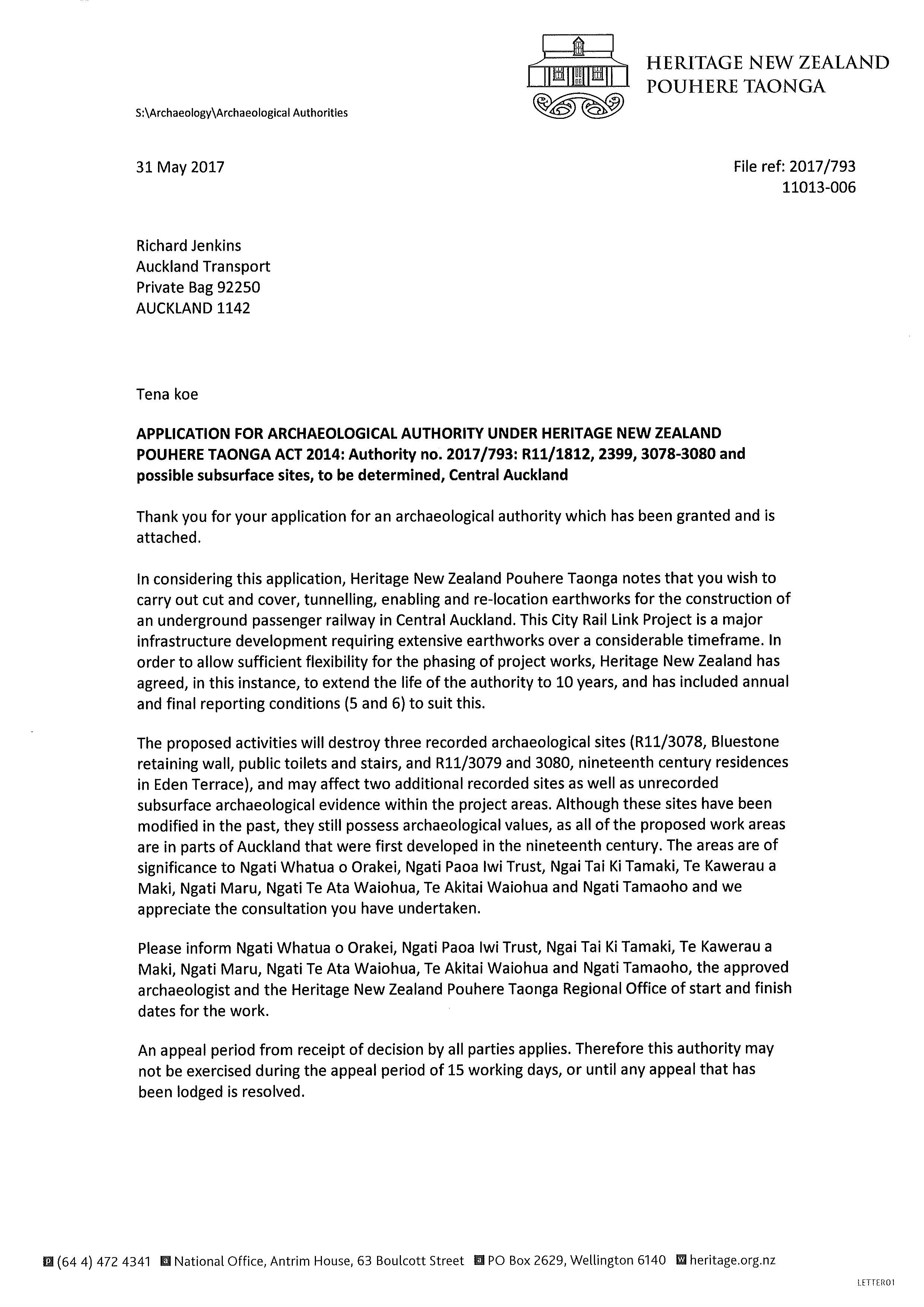
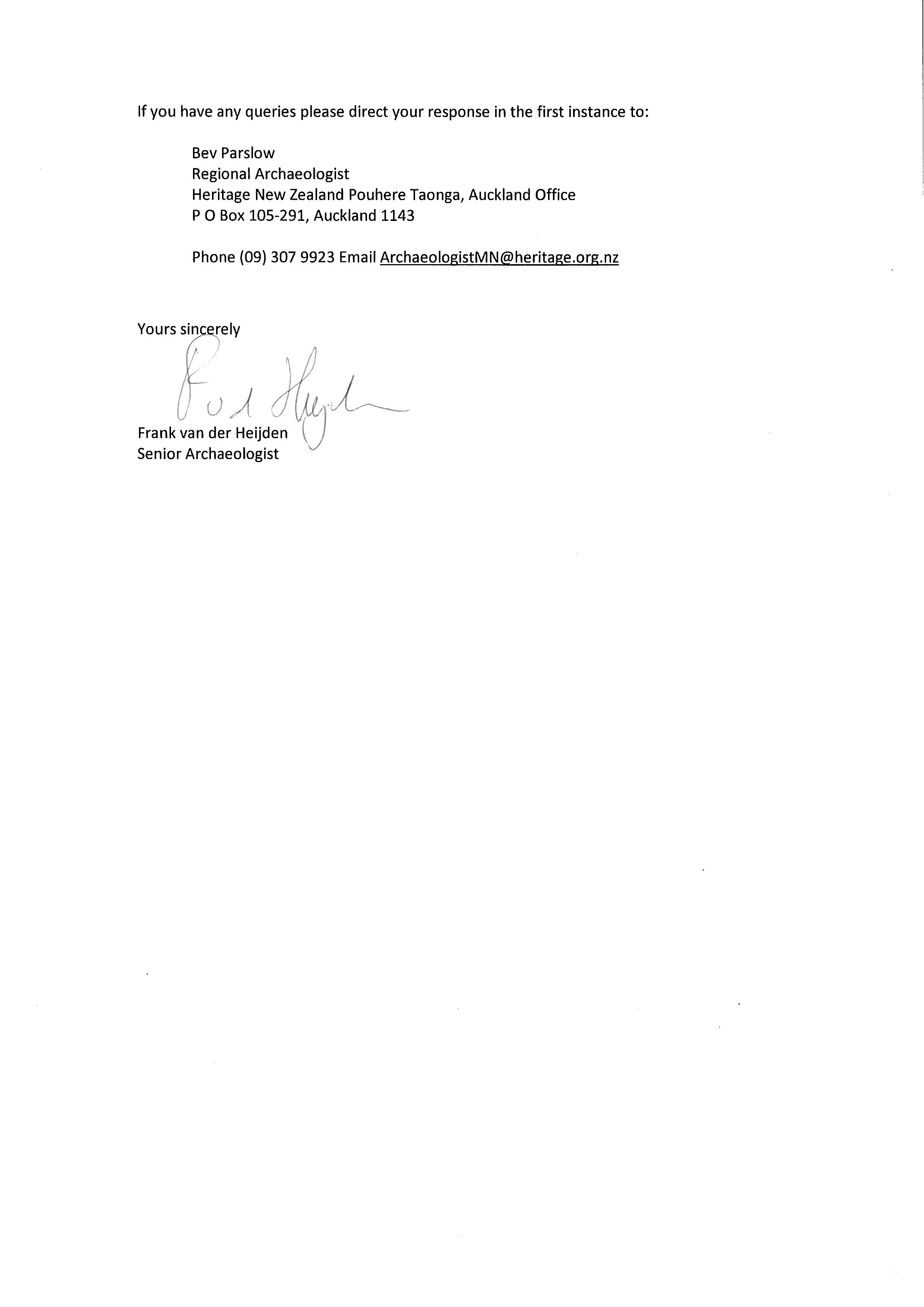
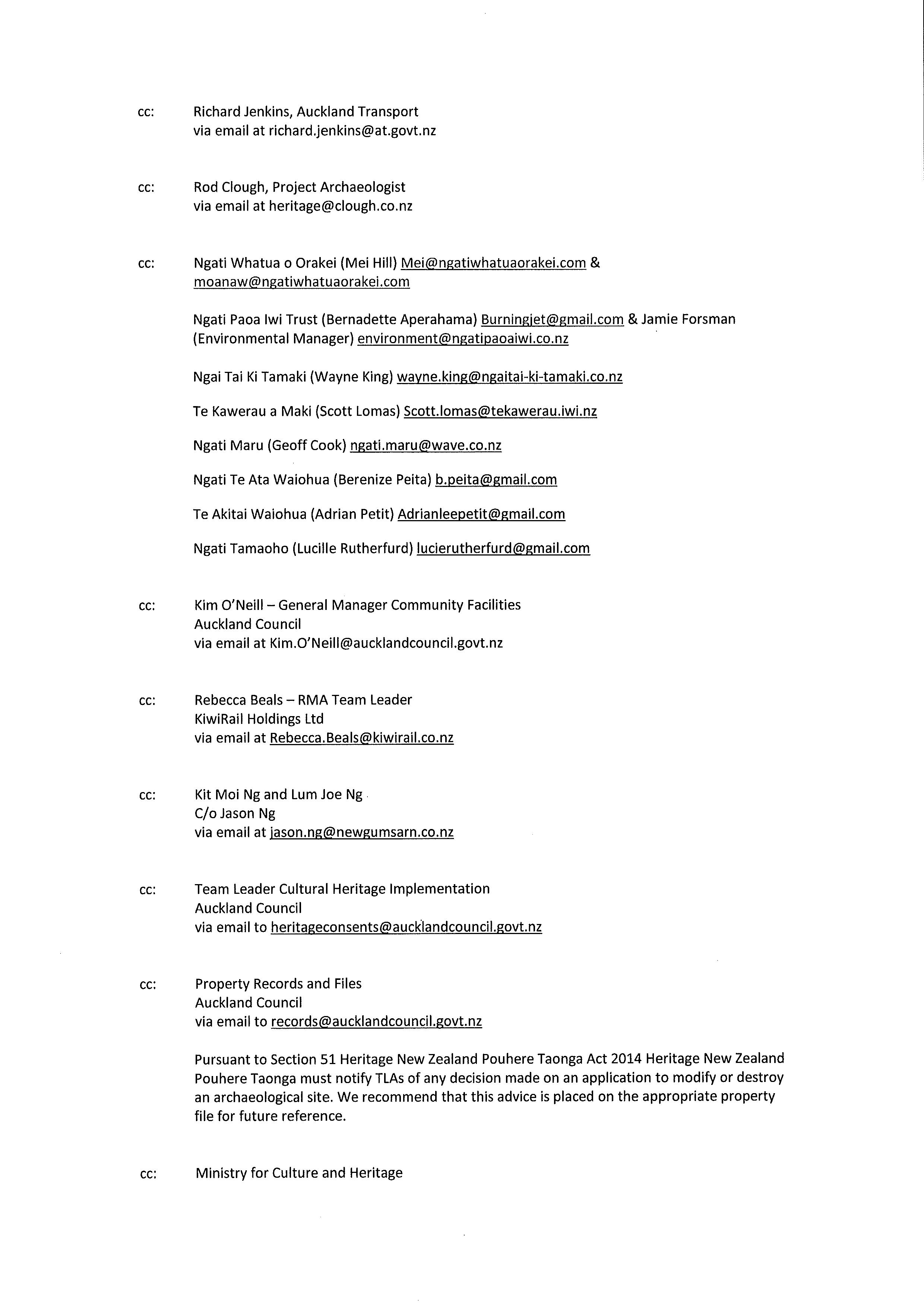

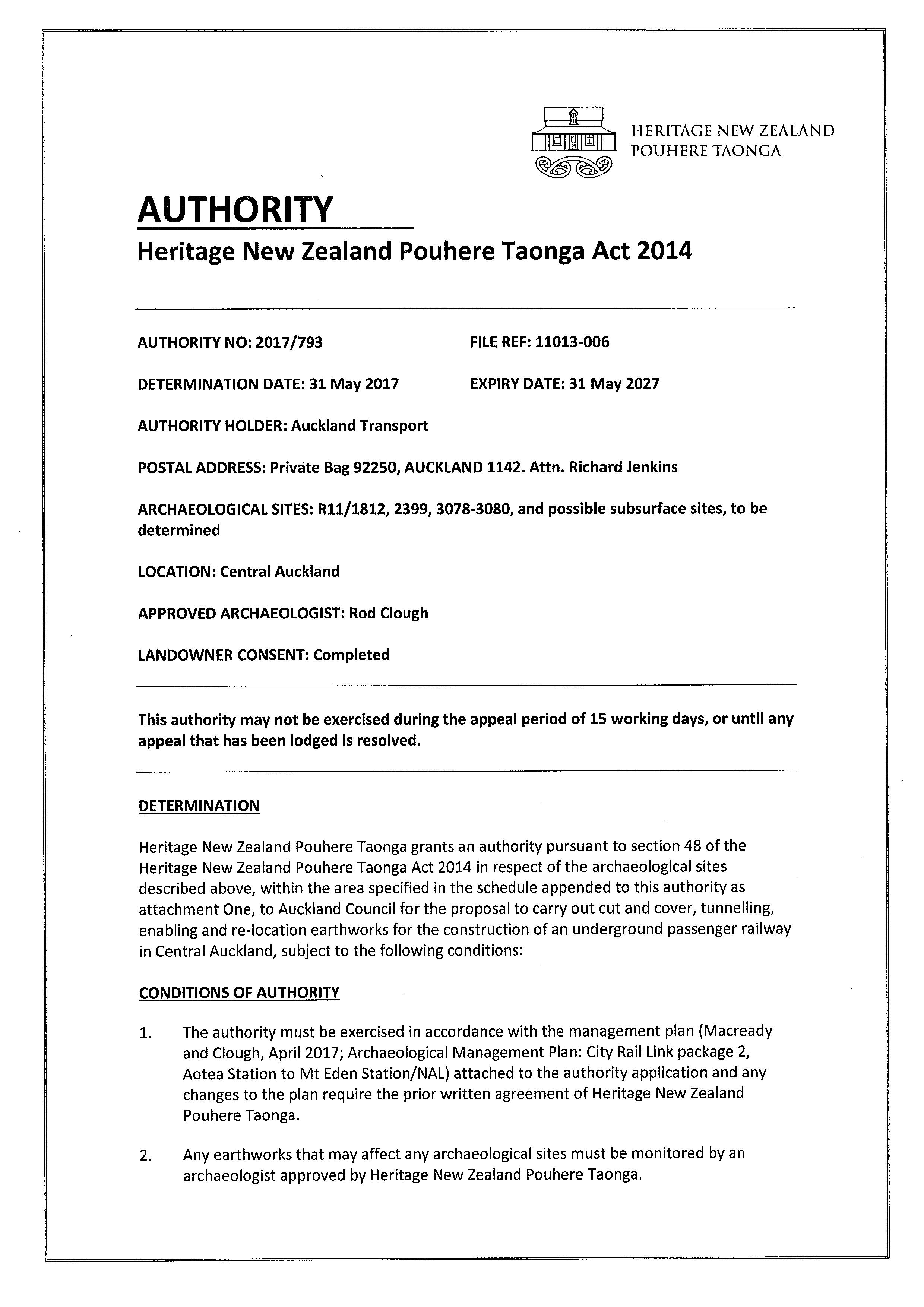

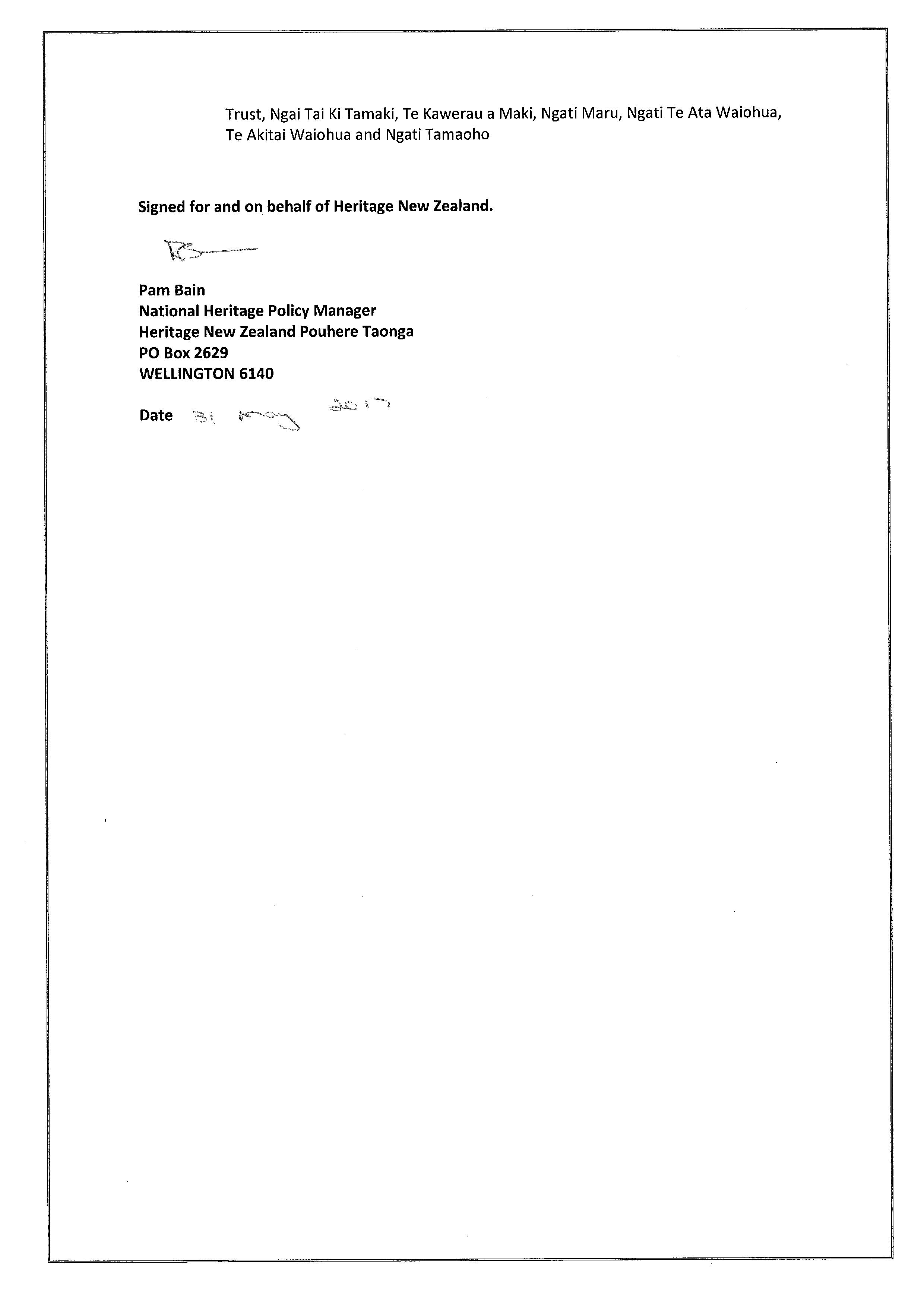
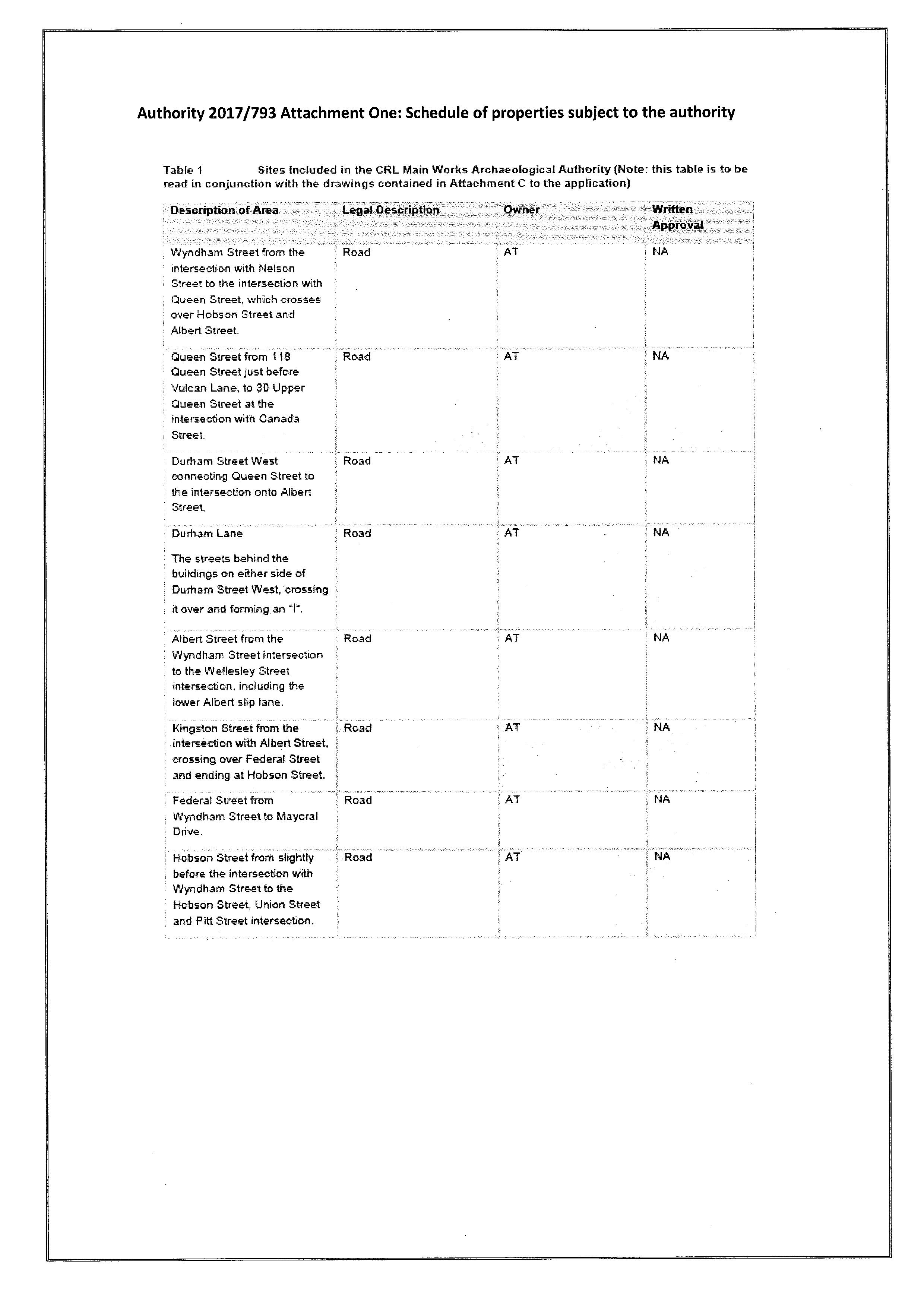
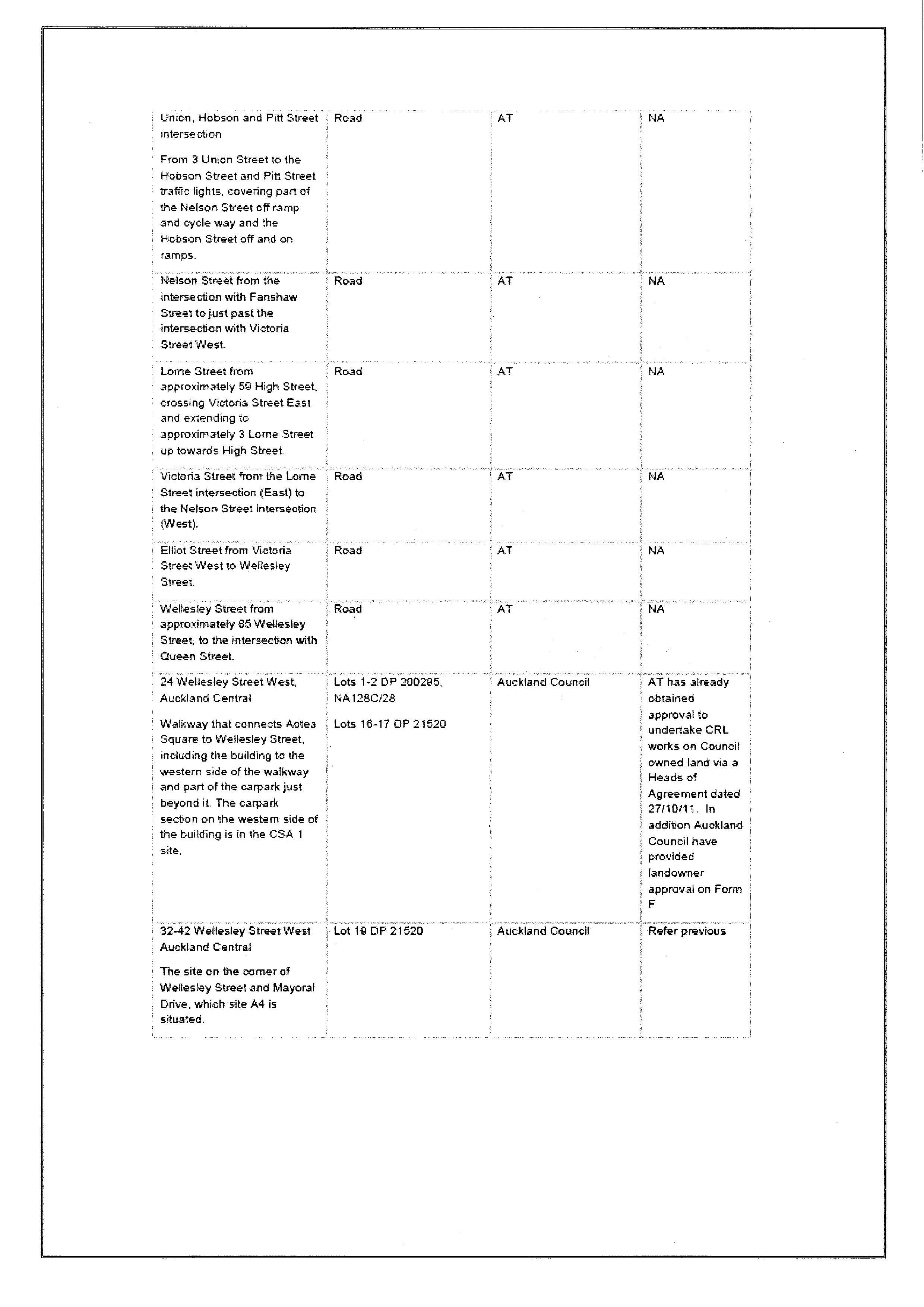
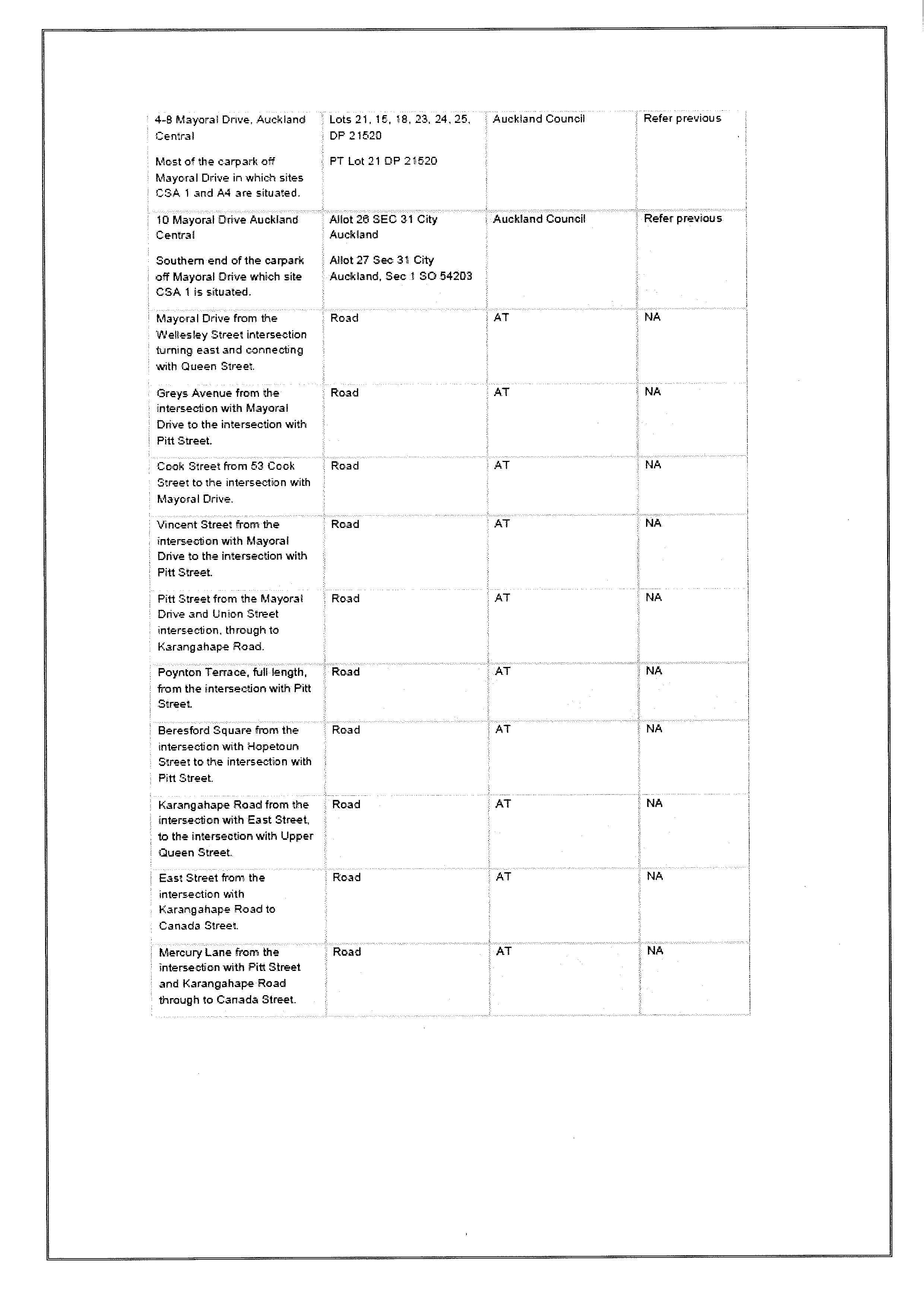
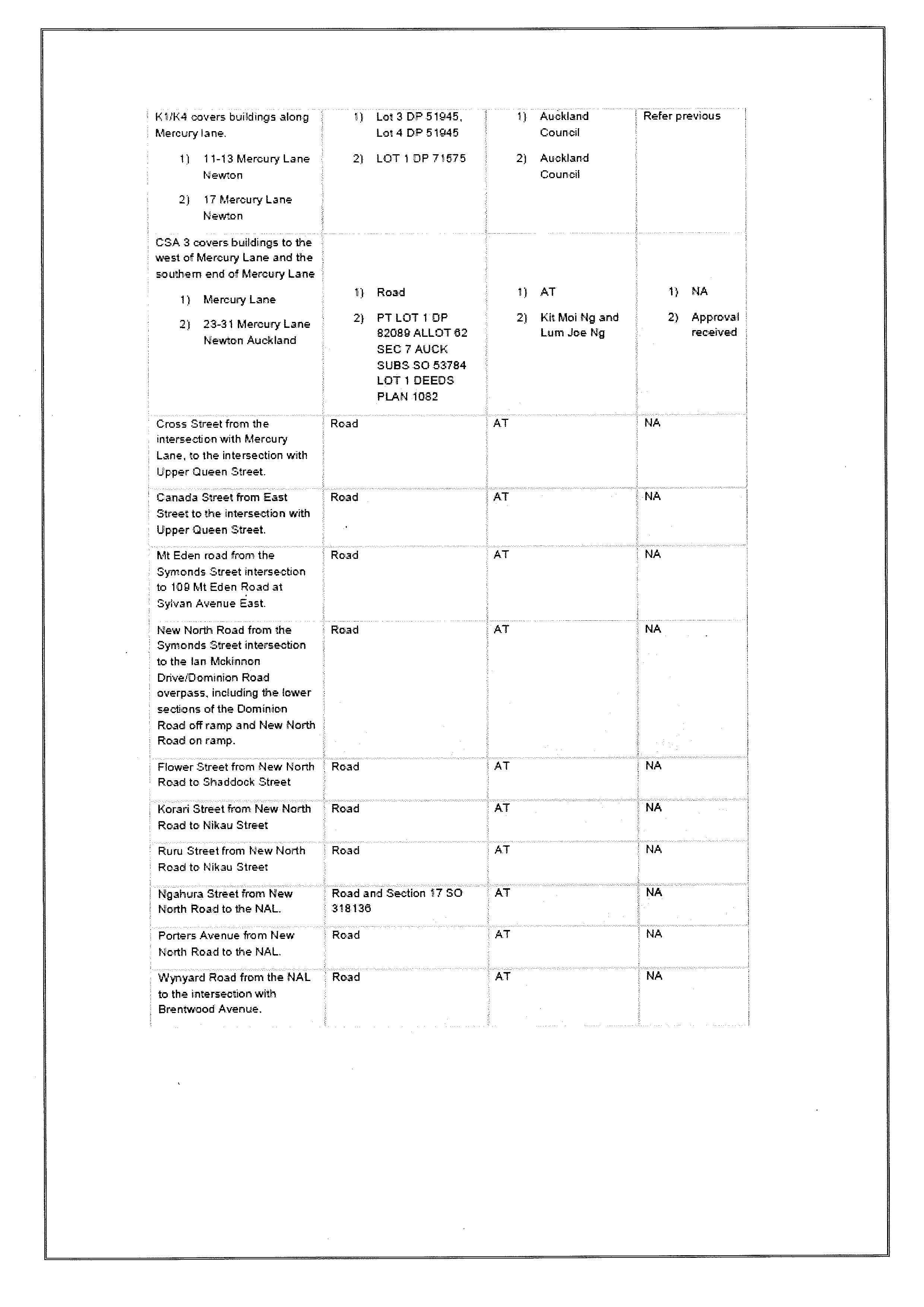
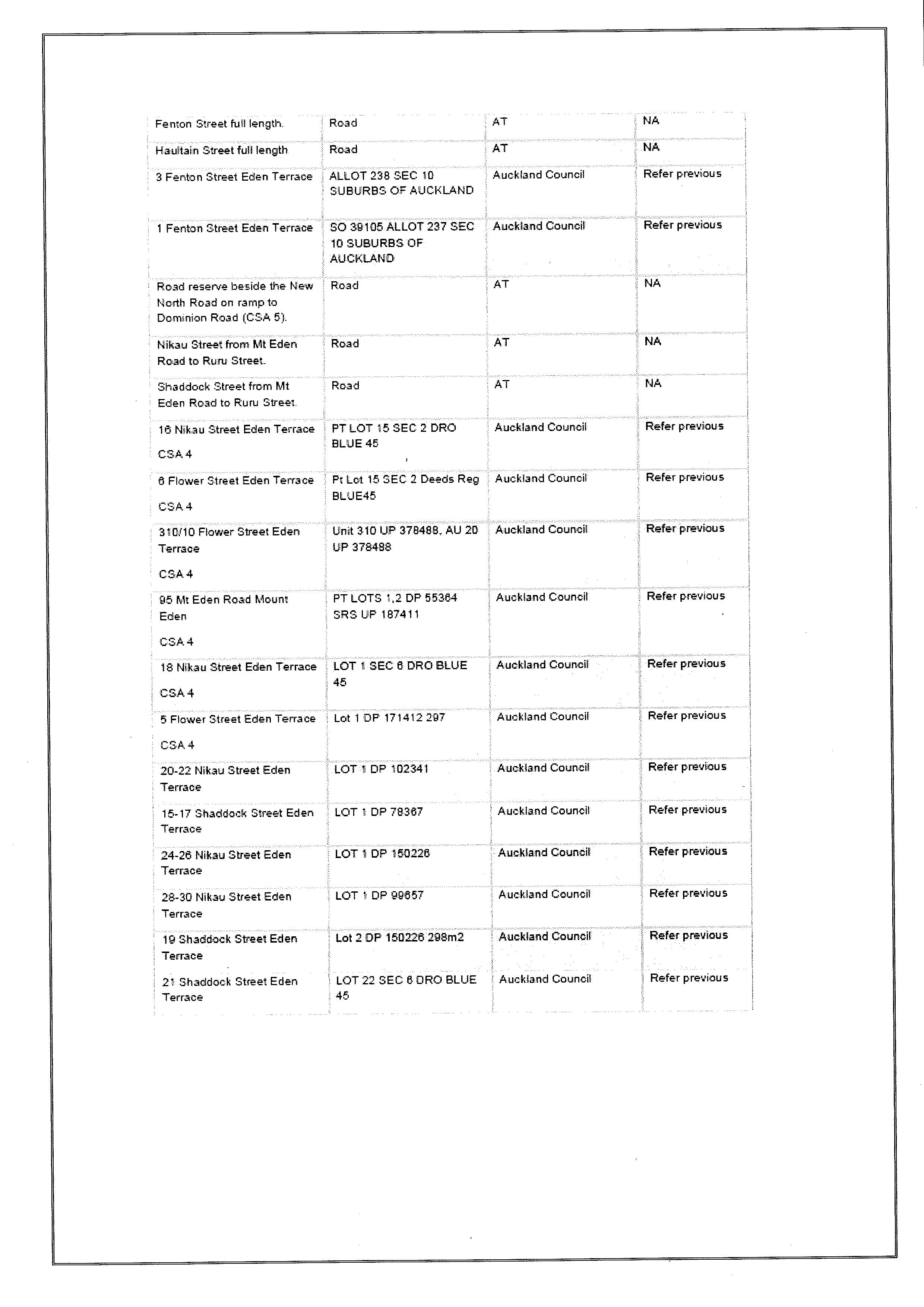
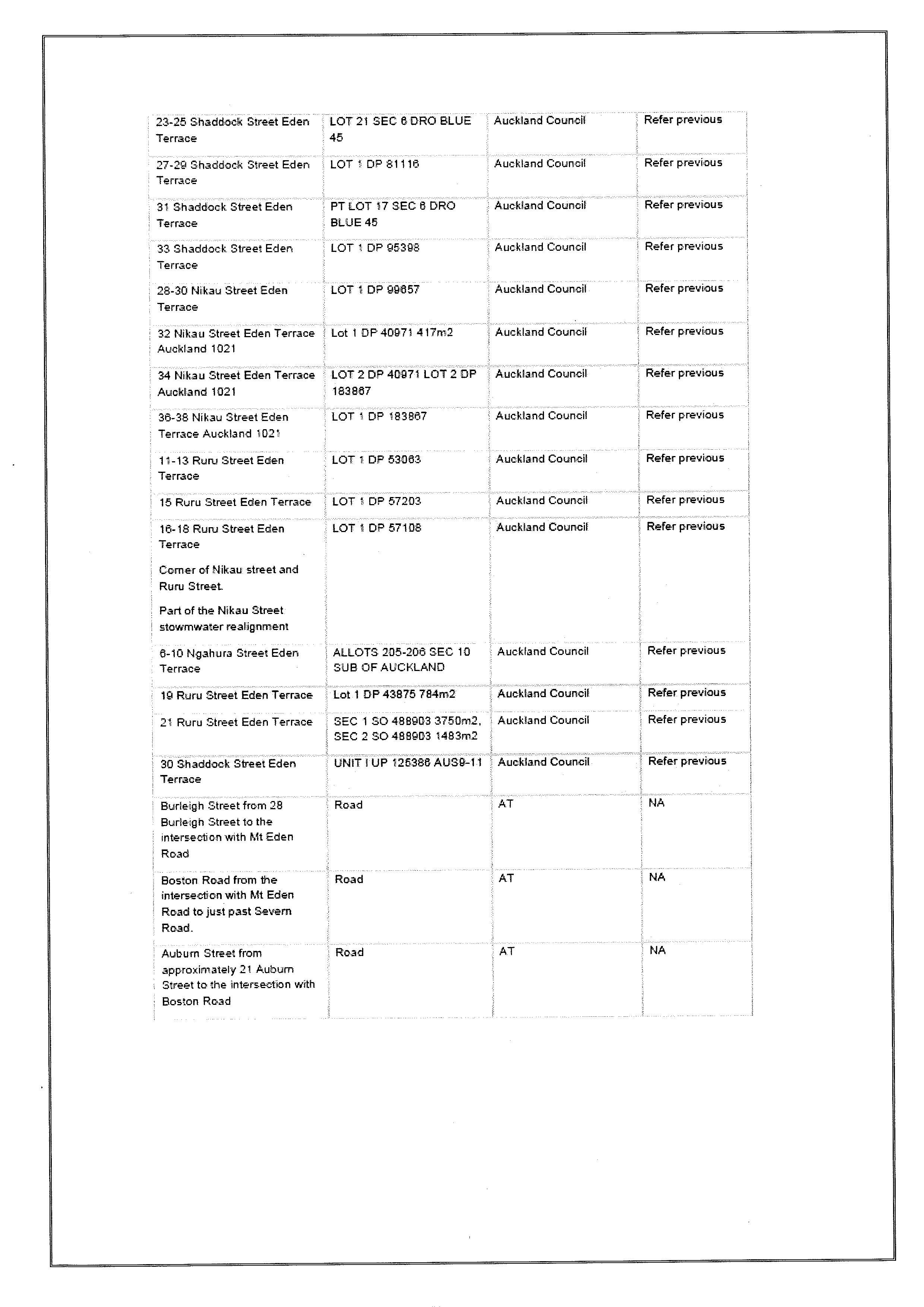

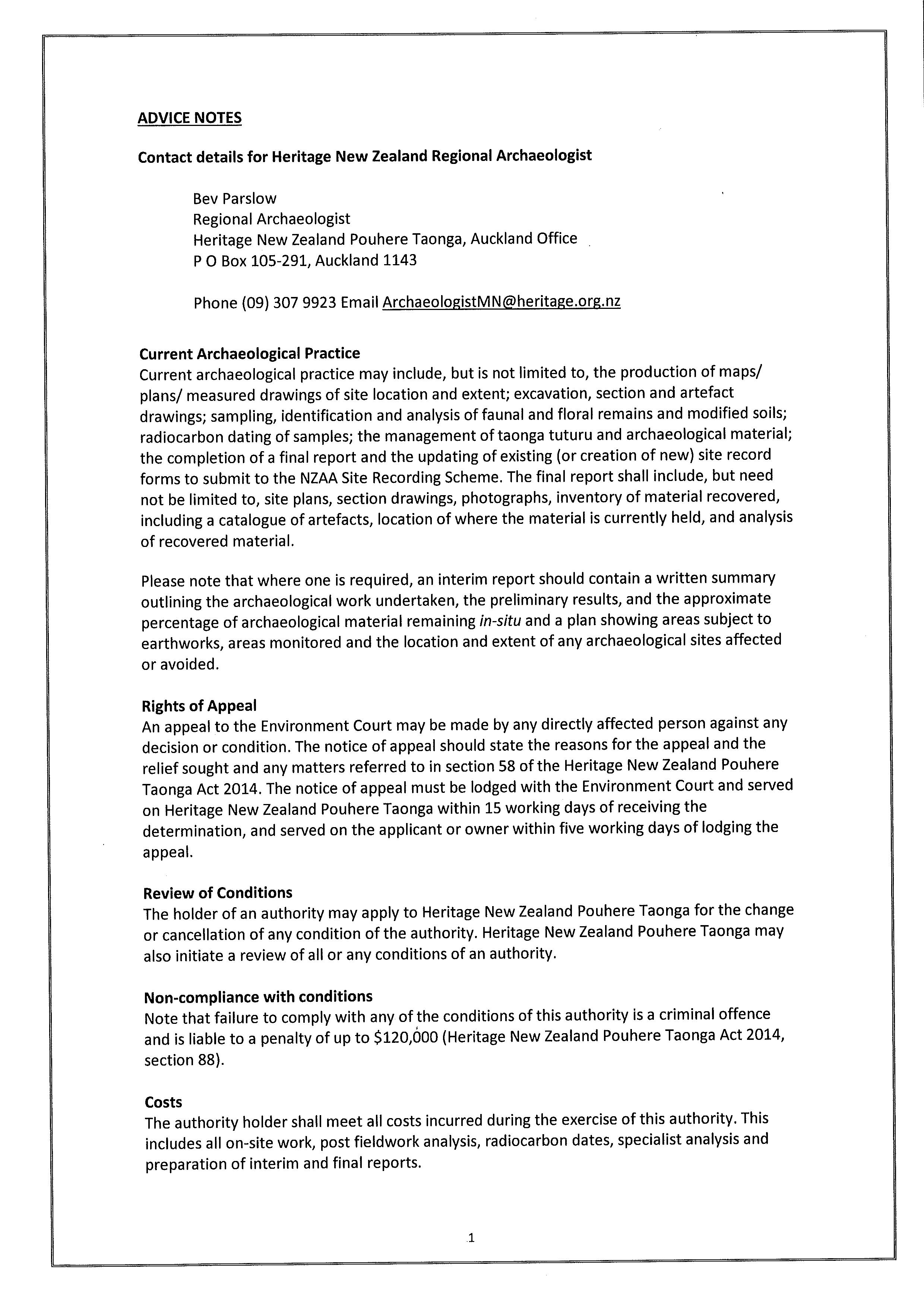

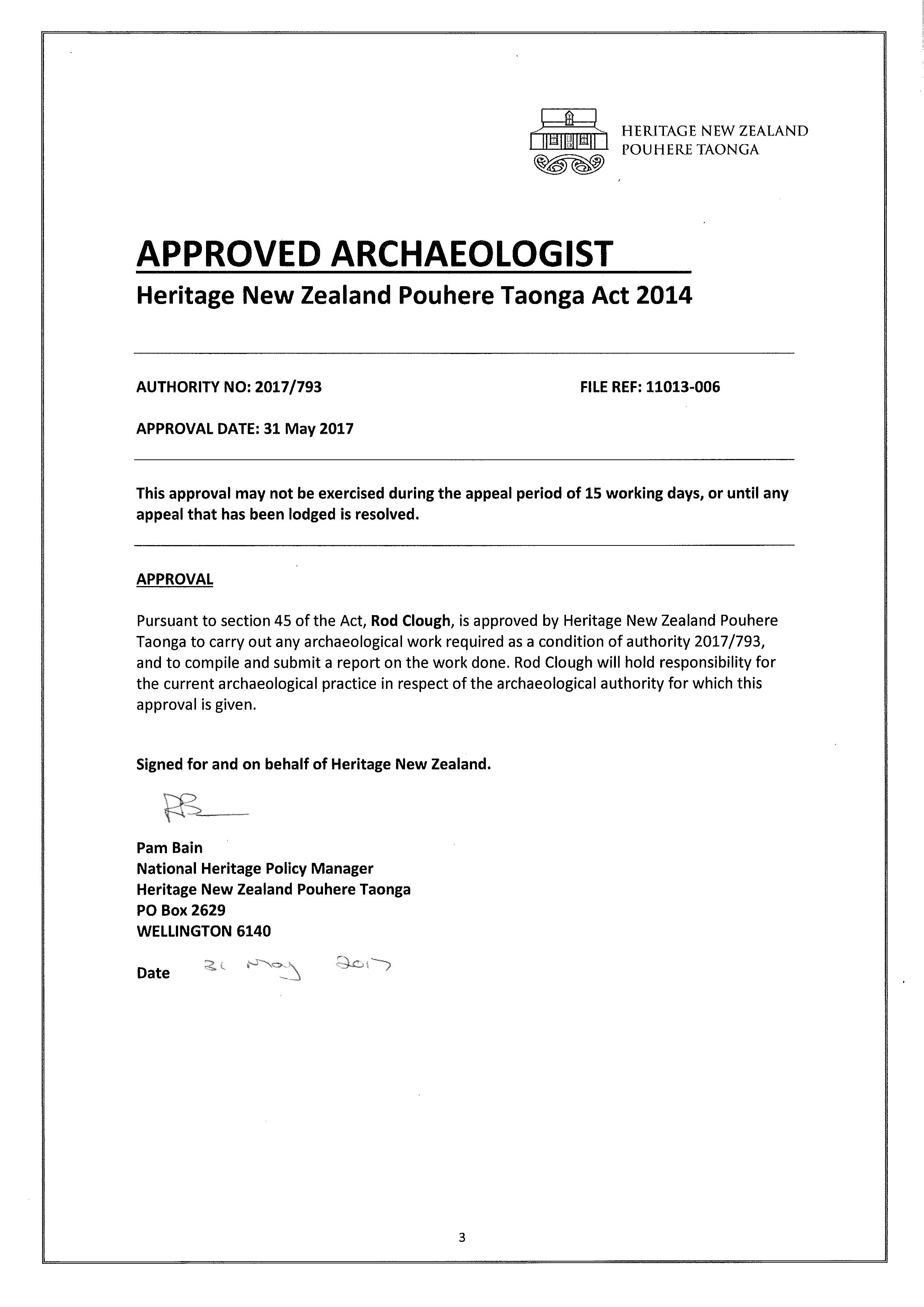
No issues relating to historic heritage were raised at the CLG meeting on 11 December 2018
IPRP Comments
Peer Reviewer:
Date:
3.1
5.1
Project Archaeologist roles and responsibilities states the Project Archaeologist will ensure “that the archaeological team adheres to the contractor’s site safety requirements.” Please check whether the contractor’s safety requirement of CRLL’s have precedence and amend if required.
31 Shaddock Street and 6 Flower Street states that “the buildings will be fully recorded by an experienced buildings archaeologist to a Level IV standard as set out in the HNZPT 2014 Guidelines for Investigation and Recording of Buildings.”
Subsequent to the preparation of the DWP, these guidelines have been superseded by the HNZPT 2018 Investigation and Recording of Buildings and Standing Structures, and the appropriate recording level is now Level III. Please amend.
5.8 Stand Down Periods
This section states that “timeframes need to be flexible” and section 5.6 states that “sufficient time and opportunity will be allowed for the recording and sampling of any archaeological features or
No change. The contractor’s site safety requirements apply to anyone entering the site.
Table 5.1 has been amended to include a stand down during soft strip demolition.
Otherwise no changes have been made, as the contents of this table are consistent with the Archaeological
deposits encountered.” However, Table 5.1 provides for Maximum Stand Down Periods, which is incompatible with flexible timeframes and sufficient time and opportunity, as well as Condition 3 of HNZPT authority2017/793 which states that “All archaeological evidence encountered during the exercise of this authority must be investigated, recorded and analysed in accordance with current archaeological practice.” Current archaeological practice is potentially time consuming and, while it is understood that the archaeologist will make very reasonable effort to clear the area a quickly as possible, this may not always be possible within the time frames outlined on Table 5.1. This table also states “Note that there may be special circumstances in which a longer period of stand down for investigation is deemed necessary by either HNZPT or Auckland Council.” This is potentially confusing.
I suggest that Table 5.1 be changed to Stand Down Triggers, the second column deleted and the table re-formatted to include relevant HNZPT, Council and mana whenua response times.
No allowance is made for stand down
Management Plan approved under the Heritage NZ Authority (2017/793) and have been standard for previous Authorities and Heritage Management Plans approved by Council for other projects.
We do not consider there is incompatibility between the fact that contractor’s timeframes need to be flexible, and the minimum stand down periods given, as the necessary flexibility sits within those timeframes. Limited if any remains are likely to be encountered during site clearance and a slightly longer stand down period is given for any significant archaeological remains encountered, with appropriate recognition that HNZPT or Council may require a longer period for investigating any significant discoveries. In addition, there is always the option of deferring investigations until the main works stage, if necessary.
CRLL is seeking ISCA (infrastructure Sustainability Council of Australia) IS (infrastructure Sustainability) Rating for the whole project lifecycle where the requirements as per ISCA CRL IS Technical Manual – Mahi Rauora Aratohu - Version 1.2 are essential to achieve the Project’s sustainability goal (Reference to CRLL minimum requirements - Appendices 10, 23 and 24 of the contract documents). This Appendix includes IS requirements that are necessary to achieve a target level 2 of Her-1 and Her-2 ISCA credits. These requirements remain subject to change as the project goes forward. Hence, the below Table to be reviewed, amended (as and if needed) and confirmed to meet the target level that will be set and agreed upon. The relevant required evidence(s) to achieve the target to be provided at appropriate timing. ISCA
Refer to Table 1.1 of this DWP
Heritage assessment and management
Benchmark
Community heritage values have been identified through consultation and integrated into studies.
AND
Measures to minimise adverse impacts to heritage during construction have been identified and implemented.
AND
Community and key stakeholders have participated in the heritage studies.
AND
Heritage values beyond those listed in government registers have been identified, considered and addressed.
AND
Heritage has been interpreted to promote local heritage values.
Evidence
Heritage report with assessment of lists / registers
CV’s of persons undertaking surveys Minutes of community consultation
Sections 2 and 3, and Table 3.1
Section 6 for consultation
Sections 4 and 5
Sections 5, 6 and 7
Sections 5, 5.1, 5.3, 5.4, 5.6, 5.7, 5.8, 5.9 and 5.10
Section 3.1, 5.9, HNZPT Authority 2017/793
Her-2 2
Monitoring of heritage
Construction Requirements
Records of stakeholder participation in heritage studies. Heritage management plan
Benchmark
Monitoring of heritage is undertaken at appropriate intervals during construction AND Monitoring and modelling demonstrates maintenance of heritage values.
Evidence Monitoring plans. Monitoring reports.
CV’s of suitably qualified professional or committee terms of reference.
Oversight reports or meeting minutes
How we Aim to achieve this
Refer to Table 1.1 of this DWP
Section 5 and section 5.10 for reporting /lists register
Section 5.10 requires reporting upon completion of the project
An appropriately qualified Archaeologist has been approved under HNZPT Authority 2017/793 (Appendix A)